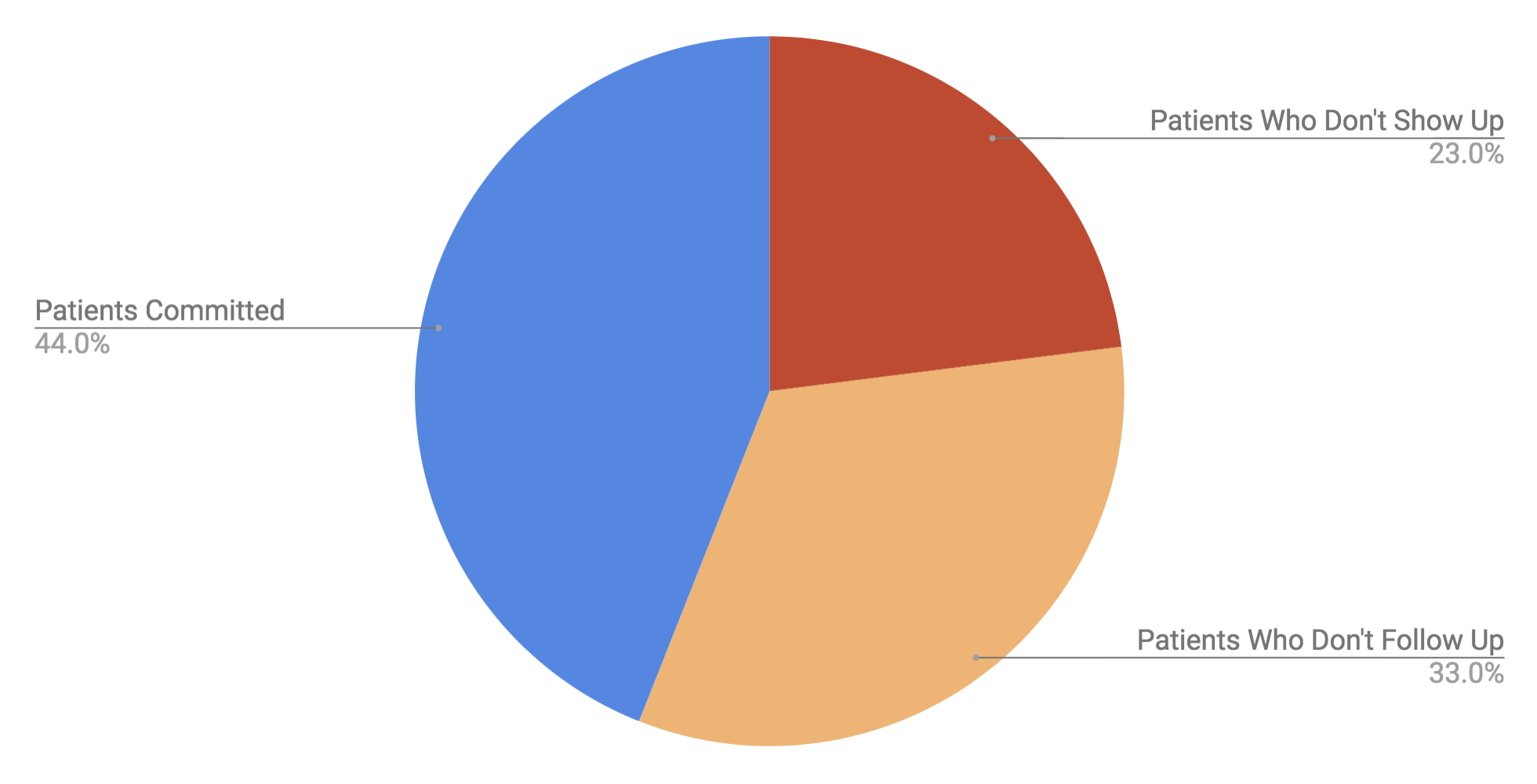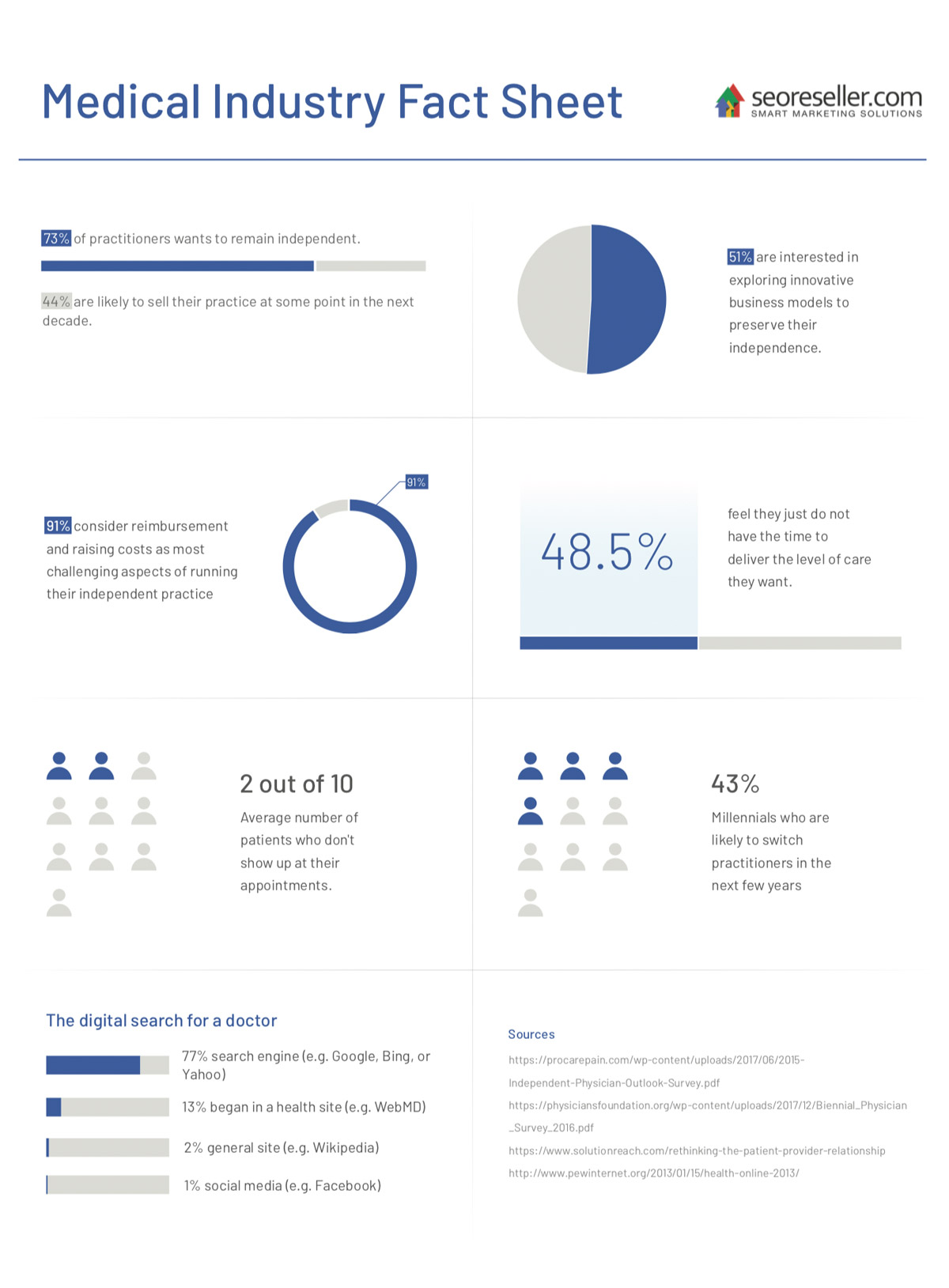The American medical landscape is changing.
In 2000, 57% of physicians practiced independently. That figure dropped to 31% in 2018. These days being an employed physician is the norm.
And you can’t blame these guys. It’s just not good business to let go of a chance at stability and security. Recent developments have made a mess of the insurance reimbursement process, making financial forecasting complex. Also, operating costs are on the rise (1). What chance does a single practice have against these?
Physicians have to approach their survival and growth from two angles.
- They need to build and grow a steady stream of referrals.
- They need to leverage their specialization and competencies.
In short, they need to build up their visibility and patient trust.
We’ll tell you how a simple, well-crafted digital marketing strategy addresses these concerns later in the article. But first, we’ll dive into the medical world to gain a deep understanding of the industry and diagnose its problems.
If you’re a healthcare practitioner or a digital marketer servicing the medical industry, this is the post you’ve been waiting for. Let’s get started.
An Industry’s Growing Pains Operating Costs & Workload
Starting a medical practice is no walk in the park. It is estimated that a physician needs at least:
- $20,000 to $30,000 for the initial investment, and;
- roughly $6000/month in operating costs
to cover everything, including office space, payroll, vendors, equipment, and insurance.
We need to keep in mind that these costs can vary heavily. Location (office space, insurance), specialty (equipment and insurance again), and target market affect overall costs. In several instances, investments go up to more than $100,000!
As if that isn’t enough to leave anyone reeling, the other concerns keep piling up. Equipment needs to be maintained, checked, and replaced regularly, for one. The biggest hurdle, though, is paperwork.
Just when you thought you’d escaped that dreaded word by going digital, life pulls a fast one on you. An astonishing 72.1% of physicians estimate that paperwork negatively impacts their capacity to provide good care to their patients (2). All in all, 80.6% of practitioners feel they are stretched thin (76.8% for independents); 48.6% feel they are close to burning out.
Physicians want to provide the highest quality of care, but 48.5% of them feel that they just do not have the time to deliver the level of care that they want.
Dropping loyalty & raising competition
The constant pressure to meet quotas has dire consequences. Because physicians need to handle administrative tasks on top of everything else, their workload has grown cumbersome.
This in itself is a problem. But think about how it translates into their job. Patients will indirectly feel the brunt of their physicians’ exhaustion. Overworked physicians deliver subpar care, negatively affecting patient satisfaction.

23% of Patients don’t show up at their appointments. 33% drop their follow-up consultations.
Competition isn’t letting up either. If anything, it’s become fiercer. More practitioners are moving to hospitals with a bigger healthcare marketing strategy budget under the umbrella buzzword “Integrated Healthcare.”
Big money is backing Integrated Healthcare’s efforts. This means that patients can switch physicians with a single click. In the era of “on-demand” everything, the setup is perfect. Actors like Zocdoc facilitate the intermediation and reach out to younger generations.
- 43% of Millennials are likely to switch in the next few years
- 20% of Baby Boomers are likely to switch physicians in the next three years
Those employed by big-budget hospitals are the winners right now. But if there are winners, then there too are losers. Who are they? None other than independent physicians. Providing excellent service within their profession and the experience they deliver to clients is more crucial than ever.
Regulatory constraints: HIPAA
The situation above is tricky on its own, even when we aren’t talking about a heavily regulated industry. The thing is, we are. We’ll have to keep a few — but important — regulations in mind. Specifically: HIPAA constraints.
HIPAA is short for Health Insurance Portability and Accountability Act. The 1996 act provides a legislative framework to ensure medical data is handled safely; it aims to protect patients’ anonymity. Violators will be subject to severe penalties, including jail time. Be extra vigilant about the following:
Patient Anonymity. Hackers are smart. But they don’t have to be particularly so or exert much effort if the information is given away. Remember: even a combination of basic details can compromise a patient’s cybersecurity. Never post any information that can be used to identify the patient. Handle Personal Identifiable Information (PII) like lives depended on it ( because it does).
Compliant websites. HIPAA-compliant websites encrypt patient data. These include information that people input on online contact forms. The minimum will be to install an SSL certificate to increase protection for patient data stored online. Make sure you read about HIPAA compliance before handling personal information (3).
How Digital Marketing Can Help Save the Day
Increasing Visibility
We’ve had you wait long enough. So, here it is. Say hello to the primer on your digital marketing strategy with our medical industry fact sheet.

Website
Everything starts with a website, an entity’s online presence. When done well, it makes an individual or business look good. When a website is up-to-date, modern, responsive, and secure, it’s an independent physician’s best friend. We can’t stress enough how many benefits it will yield.
Before anything else, here’s how such a website does it:
- Show activity. A practice, like any business, has to show signs of life. Your site should feature news, produce fresh content regularly, and respond to comments.
- Communicate the difference. Like your keyword strategy, your website should reflect the value you provide (e.g., pain management, or dentistry for children). We’ll discuss this in-depth in the content marketing section. Your takeaway at this point should be to focus on your strengths. Copying your competitors is a big no-no!
- Be mobile-friendly. Chances are you’re reading this post on your phone. Patients do the same. Make sure your website reads well on a mobile platform. After all, more than 57% of searches are made on smartphones and tablets.
- Secure your information. Because, well, HIPAA. Need I say more?
Once the website complies with all these criteria, it’s time to optimize for search engines.
SEO Strategy
Make no mistake: patients are online. They are able to do extensive research, and they’re more particular about the services they receive. A 2013 Pew Research Center study found that 72% of internet users searched online for health information. This includes queries about serious conditions, general health information, and minor health problems. Of these seekers
- 77% began in the search engine, such as Google, Bing, or Yahoo;
- 13% began in a health site like WebMD;
- 2% started at a general site like Wikipedia; and
- 1% started at a social media site like Facebook.
What does this mean? Simple. The lion’s share of searchers is on search engines. It’s not enough to be present on Google. Capture them by ranking in the top positions on the keywords that matter for the physician.
Depending on the local competition, it’s critical for doctors to specialize and work on a unique positioning. Let’s take the market for dentists as an example. The industry is saturated. As a result, it’s over-competitive. By focusing on a target market (e.g., children) and developing a dental SEO strategy, a dentist can develop his or her unique brand position.
The keyword research in a strong local SEO campaign will then be executed in relation to their unique positioning that they’ve defined. You’ll have to aim for positions 1 to 3 on the keywords that will lead to high conversions. Case in point: an August 2018 study of more than 960,000 keywords showed the disparity of traffic among the organic results in the search engine results page (SERP) based on rank:
- The first organic search result on Google had a click-through rate (CTR) of 32.73 (desktop search) and 23.57 (mobile).
- The second result garnered a CTR of 13.44 (desktop) and 12.26 (mobile).
- The tenth spot — the last search result on the first SERP — earned a CTR of 1.08 (desktop) and 0.76 (mobile).
The difference between the top and the tenth organic search result is nothing to scoff at. It’s even more amazing when you think how the market share for the following results is negligible.
Optimize Google My Business presence and the local listings next. This will allow for two things:
- Your presence on Google Maps and in the search results with special snippets.
- Monitoring capability for your online reputation.
Use our Google My Business dashboard to better track performance and see more opportunities to optimize for local results. Now that we’ve shown how important it is to rank at the top search engine spots, where do we go from here? Fear not. We’ve got you.
Triggering, Controlling and Maintaining Trust
One stat says it all: 44% of internet users look online for information about doctors or other health professionals. It’s high time medical professionals established and took control of their brand. Nowadays, trust starts online.
12% of the patients posted their feedback on social media; 6% expressed their thoughts on the business’ website.
Content Strategy
A study published in the journal Procedia – Social and Behavioral Sciences found that, for a third of participants, the most important factor in choosing a physician is his or her knowledge and experience. Why is this relevant to us? Because it gives us an idea of what patients are looking for. We can leverage the finding in two ways in our SEO management solutions for medical services:
- Generate Quality Content. Credibility, knowledge, experience – these are three things that matter to your clients’ patients. When producing content, make sure it contains relevant and up-to-date information. Anything that doesn’t fit this criterion has no place on the site. Throw it away! No exceptions. Valuable content answers no less than the patient’s concerns.
- Emphasize Specialization. A physician who can discuss various subject matters is helpful — to a point. Some patients are past this stage; they have particular needs that only a specialist can address. Lead patients to the right doctor by playing to a healthcare provider’s strengths and listing down their industry experience. This helps patients make an informed decision.
Reputation Management
A spotless online image is crucial to building credibility. A 2011 study from the Pew Research Center revealed that 44% of internet users look online for information about a primary healthcare provider or other healthcare professionals. Meanwhile, 36% searched online for hospital and medical facility information. They had two goals.
- To determine the doctor’s credibility.
- To see if they provide great patient experiences.
All well and good. But knowing patient intent is not the be-all and end-all. Patient reviews can still make or break a physician’s authority online. A 2012 study from Google found that after appointments, 12% of the patients posted their feedback on social media; 6% expressed their thoughts on the business’ website. These numbers prove one thing: reputation management should be in any strategy, whether you’re doing digital marketing for dentists or plastic surgery SEO.
In a perfect world, all the reviews would be praises and glowing recommendations. The world doesn’t work that way, though. Here’s how to deal with feedback gracefully:
- Field Reviews. Patients don’t always trust the reviews on the doctor’s website. They prefer reading testimonials from third-party sites. So, list your client on popular review sites like Yelp to encourage reviews from current and past patients. Once these are in place, respond to reviews. Always, and promptly. Be on your best behavior, too. Thank patients who posted positive feedback and field negative comments. Owning up to the issue and doing something to rectify it is important.
For more complicated matters, take the discussion out of the thread. Invite patients with concerns to resolve the issue privately.
- Monitor Conversations. Reacting to reviews is a good healthcare marketing strategy. But if anything we’ve discussed is anything to go by, you’ll know that that isn’t enough. Stay on top of chatter about your clients. Find out what patients say about their practice. You can use patients’ comments to help improve their experience in the clinic. As a bonus: you can also head off minor issues before they blow up online.
- Ensure Consistent Listings. Patients rely heavily on Google for information. So, ask yourself: Is my client’s online information accurate and up-to-date? Once this checks out, take a step back again. Now ask: Are their listings consistent across all directories? Today’s empowered users won’t hesitate to move on from your client if they don’t get what they need ASAP.
Loyalty
Attracting and engaging patients is a huge undertaking. And it’s only half the battle. Physicians need to work on making them stay, too. To put it into perspective, it’s estimated that:
- Clinics lose $107 in income per missed visit or a loss of over $1.1 million per year (out of a net revenue of $5.7 million)
- Appointment no-shows cost practices $150 billion annually
- Every 1% reduction in a 17% no-show rate increases clinic income by almost $70,000
Reasons for changing doctors vary. The lack of communication with the primary care physician is one. The need for a second opinion is another. Feelings of uncertainty of the doctor’s credibility add to the lack of trust and loyalty, moreover.
These concerns have one thing in common: it’s all about the patient.
Fortunately, it’s not a situation that’s out of our hands. Focusing on loyalty is part of a holistic SEO strategy for any medical field – be it chiropractor SEO, dental marketing, or plastic surgeon SEO strategies.
It’s proven that trust is the primary factor of loyalty. And empathy is one of the key levers, alongside competence and ethics, to create trust. Thus, healthcare professionals who display genuine concern for their patients are most successful at keeping said patients. Emphasize how important care is to patients.
Tackling the No-show issue
Patients have a lot on their plate. They deal with school, work, and other daily activities. With all these demands on their time, the patient might lose focus on the important things. Things like their health. According to a recent study by Timothy Gibhart, DNP, FNP-C, the main reasons for patient no-shows that practices continue to face, are surrounded by problems with:
- Mobility/transport problems
- Prioritization without communicating to the practices
- Challenges contacting the practice
- Financial difficulty
- Forgetfulness
Primary care professionals should see this for the opportunity that it is. They can demonstrate their care for patients by reminding them of their scheduled appointments, and that communicating with the practice is key for their well-being. Here are some ways to combat and lower instances of no-shows at clinics:
- Patient reminders (mail, voice, text, and emails). When used together, patient reminders had a multiplicative effect. They were 70% more successful at reducing patient no-show rates than any individual reminder.
- Intelligent overbooking. Using a program that factors patient and appointment characteristics, clinics can anticipate no-show rates. They can use it to overbook the physician’s calendar.
- Probation. A probationary system penalizes patients with the highest instances of no-shows with a lower priority status over others. Based on some studies, it’s possible for the no-show rate to drop to 17.7% from a baseline rate of 33.3%.
Multiple software can help with setting up an automated system that sends appointment reminders to patients. The system can also give patients the ability to schedule their appointment. This action will notify the doctor’s office to get in touch with patients and assist them with their concerns and healthcare data. Again, HIPAA compliance needs to be checked.
52% of respondents are more likely to switch providers due to cost than medical error.
Optimize Pricing
Appreciation encourages patients to stay. But healthcare is expensive, and it can outweigh all other positive considerations about a clinic. To put it into perspective, think about this: 52% of respondents are more likely to switch due to cost than medical error.
The statistic should be a wakeup call to physicians. They need to use personalized pricing plans to optimize patient-physician relationships.
Physicians must account the financial situation of patients and help them understand:
- Their insurance plans
- How much they will owe for certain services
- Which care they need immediately versus which care they can delay
Doing so sends a message that they are 100% on the patient’s side. It goes a long way in fostering a deeper trust. Patients who know they have an ally tend to take appointments more seriously and don’t forgo certain types of care. Here are other methods that we’ve found useful:
- Packaged pricing. Package clinic services as a monthly subscription. It could include routine checks and consultations (this is perfect for family medicine, eye care, and dentistry practices). The strategy could be a great way to foster a long-standing relationship.
- Discounts. Show patients that their patronage is welcomed and appreciated. Offer discounts and promos on certain medical services. This works wonderfully for more cosmetic practices like dermatology and cosmetic surgery. Raise awareness on these perks by sending patients regular email reminders or spreading the word on social media and other digital platforms.
But our favorite tactic is to offer discounted prepaid appointments. It solves the no-show issue, and improves loyalty.
An example to conclude
Private practitioners are a key element of a country’s healthcare infrastructure. The centralization trend towards hospitals created medical deserts in the US and limited physicians’ freedom to practice their skills.
By leveraging simple strategies, a stagnant practice can thrive again, as we did for a dermatologist.
If you want to know more about medical SEO Services, Reputation Management, and Web Development services, speak with our team or create an account to visit our store, and learn more about our solutions.


